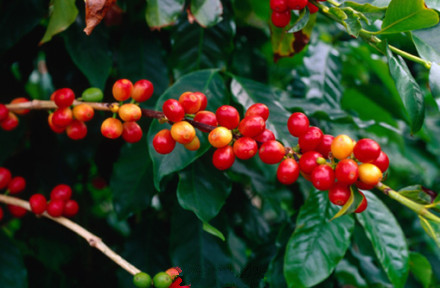The coffee producing area of Reunion.
In 1715, the first coffee trees (about 40) were transported from the Yemeni port of Moka to LaReunion, but unfortunately only two survived. By 1719, coffee plantations had begun to flourish and the first coffee beans were sold. Over the next few years, the government took a hard measure: the islanders, black and white, had to plant 100 coffee trees a year. The law was amended in 1723 to emphasize that all slaves must plant 200 mocha coffee trees a year and that anyone who damaged the coffee tree should be put to death. At that time, the island was still a French colony, called Bourbon Island, so the coffee here was called Bourbon Coffee, and the coffee produced here and Arabian coffee trees shipped from the place to other countries also had a name.

The origin of coffee in Reunion:
The coffee beans on this island are smaller, different from the Arabica species, so the bourbon coffee tree has become another new variety. Today, Bourbon Arabian coffee trees have been widely cultivated and favored around the world, but almost no coffee is grown in Reunion.
The characteristics of Reunion coffee:
The coffee produced on the island is often called "bourbon coffee". Bourbon coffee has the following characteristics:
Flavor: full-bodied, perfect taste
Suggested baking method: medium to deep baking
★★: good
The market for Reunion coffee:
Almost no coffee is grown in Reunion now.
Important Notice :
前街咖啡 FrontStreet Coffee has moved to new addredd:
FrontStreet Coffee Address: 315,Donghua East Road,GuangZhou
Tel:020 38364473
- Prev

A global coffee producer in Tahiti.
It would be a privilege to have Tahiti coffee, because it is extremely rare. Tahiti Coffee Origin: Tahiti Coffee is a kind of Arabica Coffee (TahitiArabica). Tahiti is the largest island in the Social Islands (SocietyIslands). Tahiti coffee features: Tahiti coffee.
- Next

A global coffee producer in the Democratic Republic of Sao Tome and Principe.
In 1800, the Democratic Republic of Sao Tome and Principe (SaoTomeandPrincipe) introduced Arabian coffee trees from Brazil. The Democratic Republic of Sao Tome and Principe (SaoTomeandPrincipe), the second smallest independent country in Africa, was once a Portuguese colony and did not win its independence until 1975. Coffee production in the Democratic Republic of Sao Tome and Principe: Sao Tome and Principe
Related
- Beginners will see the "Coffee pull flower" guide!
- What is the difference between ice blog purified milk and ordinary milk coffee?
- Why is the Philippines the largest producer of crops in Liberia?
- For coffee extraction, should the fine powder be retained?
- How does extracted espresso fill pressed powder? How much strength does it take to press the powder?
- How to make jasmine cold extract coffee? Is the jasmine + latte good?
- Will this little toy really make the coffee taste better? How does Lily Drip affect coffee extraction?
- Will the action of slapping the filter cup also affect coffee extraction?
- What's the difference between powder-to-water ratio and powder-to-liquid ratio?
- What is the Ethiopian local species? What does it have to do with Heirloom native species?

